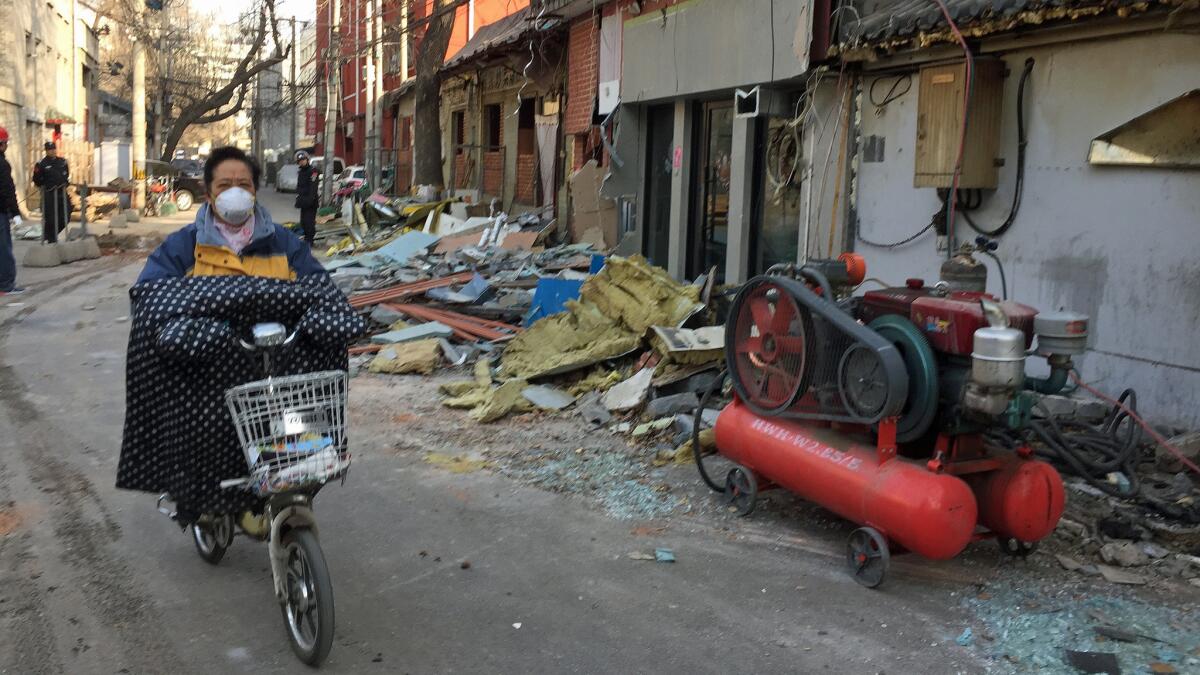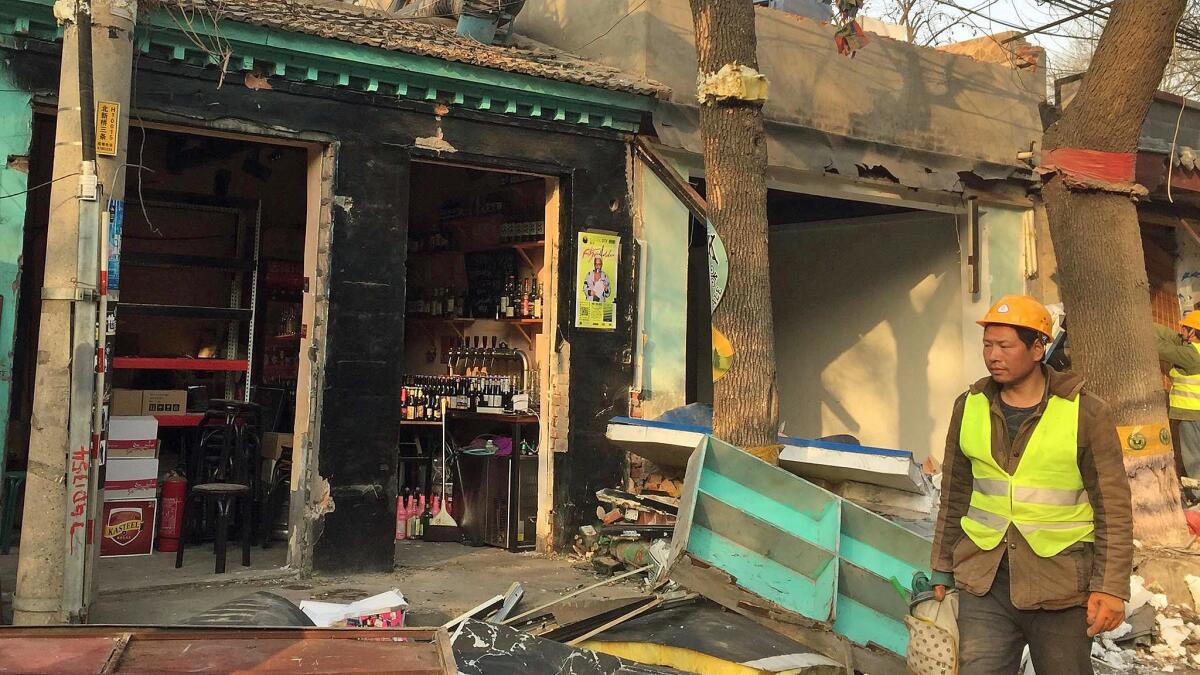If there’s debris and destruction, it must be springtime in Beijing
- Share via
Reporting from BEIJING — Beijing’s chapped, arctic winters give way to spring nearly overnight. Peach trees bloom, the sky turns from charcoal to blue, people linger outside.
And buildings get demolished.
The construction — and destruction — begins every year around this time, alongside allergies and the peeling of layers. Buzz saws sub in for alarm clocks, and the city is invaded by men wearing yellow hard hats.
But this spring is more frenzied than usual. The government has embarked on a renovation project in Beijing’s centuries-old courtyard alleyways known as hutong. These narrow streets — filled with dumpling shops, gossipy grandmothers and communal bathrooms — have largely succumbed to high-rises and haphazard renovations with concrete walls etched to look like aged bricks.
Officials want to create an “orderly, civilized and beautiful street environment” in these remaining alleys by rooting out unlicensed buildings and reducing clutter. This makes them legal and probably safer. It also threatens to erode the city’s soul.
“This is the spirit of Beijing,” hutong dweller Yang Jingxian, 30, said one evening as a three-wheeled cart clattered past, carrying doors, plywood, bricks and cement. Transforming them makes the city look “like everywhere else.”
These traditional neighborhoods, like the one I live in behind Beijing’s most iconic Buddhist temple, comprise a mix of elderly residents, foreigners on a quest for “character,” nostalgic hipsters and migrants who sleep in the back of their 10-foot noodle shop.

Nearby is Beixinqiao San Tiao, a lively hutong crammed with butcher shops, old men watching the world from a stool, and a seafood restaurant that washes its clams in the street.
That central locale one recent morning looked as though it had just survived a bomb.
Construction equipment wedged into the lane, which echoed with the clang of metal and toppling bricks. Siding poured out of corner stores. Workers fought the rising dust with hoses, and guards eyeballed piles of debris that stacked up to their shoulders.
The next morning, bikes sped down a nearly unrecognizable road, lined with redesigned concrete buildings sealed off from the street and sanitized of the chaos that once defined it.
“My heart hurts,” said Ma Jiang, 32, who watched crews knock out the windows and brick up the entrance to his pocket-size Hippo Bar. A sign now points around the corner to a side door, and customers no longer spill into street. Like others on the lane, he’s been chased inside.
Ma took the transformation in stride. At least, he said, the government paid for it.
China’s communist government grants temporary land rights to individuals, but exercises far broader authority over property than its counterpart in the United States.
Officials have valid reason to seek improvements. High-voltage lines dangle into the street like willow trees; a tarp covers holes in some roofs. Two motorcycles recently plowed into each other in front of a convenience store. Neither could see past the parked cars and delivery carts that blocked the T-shaped intersection.

Residents “can have a better quality of life once the project is done,” said Hu Xinyu, managing director of the nonprofit Beijing Cultural Heritage Protection Center. “The hutong will once again be a pleasant place to live.”
The city management commission in charge of the effort declined to comment.
These ancient alleys are victims of China’s rapid change. My landlord was born in the small courtyard house I rent, known as a siheyuan. The family, we’re told, occupied the whole compound until officials carved it into sections after the communist takeover and distributed them to multiple families.
My neighbors take great pride in the century-old, peeling wood door that opens to our equally old one-story homes. We talk about it a lot, along with the weather.
Authorities destroyed scores of hutong communities before the 2008 Olympics, when China sought to present a modern image to the world. Only a third of the city’s thousands of hutong remained a decade ago, according to a survey by the Beijing Institute of Civil Engineering and Architecture. Newer accounts vary, but preservationists believe they’ve dropped into the hundreds.
The renovations, even if well intentioned, fuel backlash because they encapsulate the uneasy tension between old Peking and the modern capital.
“The government itself is wrestling with the question of what the hutongs mean in Beijing,” said Jeremiah Jenne, a historian who leads walking tours through the alleyways. “Are they an eyesore or a tourist attraction?”
Either way, come spring, they’re a reminder that very little in Beijing is permanent.
The hammers last weekend started before 6 a.m. Our neighbor across the street had decided to remodel his home. He stood in his pajamas and directed the construction crew to hack the front wall, a comfortably clad maestro amid the rubble.
His house will stand stories tall, a new beacon in our ancient neighborhood.
Nicole Liu and Johnny Gaochao Zhang in the Times’ Beijing bureau contributed to this report.
Meyers is a special correspondent.
Twitter: @jessicameyers
ALSO
For many Chinese, President Xi Jinping may run the country, but his wife’s the real star
Born in America, Sriracha sauce tries its luck in Vietnam
Former Defense Secretary William Perry on why we didn’t go to war with North Korea
More to Read
Sign up for Essential California
The most important California stories and recommendations in your inbox every morning.
You may occasionally receive promotional content from the Los Angeles Times.










